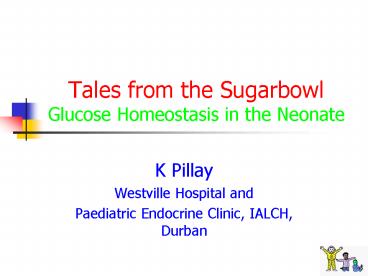Tales from the Sugarbowl Glucose Homeostasis in the Neonate - PowerPoint PPT Presentation
1 / 43
Title:
Tales from the Sugarbowl Glucose Homeostasis in the Neonate
Description:
Abnormality of regulation results in morbidity. Energy for cellular function ... Glycosuria, ketonuria, met acidosis. 1-2 weeks. Risk factors. LBW. Prematurity ... – PowerPoint PPT presentation
Number of Views:57
Avg rating:3.0/5.0
Title: Tales from the Sugarbowl Glucose Homeostasis in the Neonate
1
Tales from the SugarbowlGlucose Homeostasis in
the Neonate
- K Pillay
- Westville Hospital and
- Paediatric Endocrine Clinic, IALCH, Durban
2
Coming up
- Physiology
- Hyperglycaemia
- Hypoglycaemia
3
Glucose Homeostasis
- Tightly regulated (4.0-7.8 mmol/l)
- Regulation is the same at all ages
- Abnormality of regulation results in morbidity
- Energy for cellular function
- Ketones, other metabolites and pathways can be
used
4
The Sugarbowl
5
The Sugarbowl
6
The Sugarbowl
7
Sources of glucose (1)
- Diet (milk)
- Ingestion
- Absorption
- Digestion
- Metabolism
- Distribution
- 67 g/100mls (6.7 solution)
8
Sources of glucose (2)
- Diet (milk)
- Endogenous (stores)
- Liver, muscle, fat
- Require stimulation for release (adrenaline,
cortisol, GH, glucagon, etc.) - Enzymes systems
- 3-5 mg/kg/min
9
Disposal of glucose
- Required for energy
- Brain
- 10-25 of available glucose
- Can utilize ketones but no other substrate
- Insulin
10
Glucose utilization
Haymond M, et al. Endocrinol Metab Clin North Am
199928663
11
Insulin secretion
12
The falling glucose
4-7 mmol/l
3.5-4.0 mmol/l Insulin switched off
lt2.5 mmol/l Neuroglycopenia
3.0-3.3 mmol/l Activate glucose release.
Adrenalin, cortisol, GH, etc.
13
Glucose homeostasis
Glucose stores
Dietary glucose
Insulin
14
Neonatal diabetes
- Plasma glucose gt8 mmol/l
- Asymptomatic
- Symptomatic
- Dehydration
- FTT
- Fever
- Glycosuria, ketonuria, met acidosis
- 1-2 weeks
15
Risk factors
- LBW
- Prematurity
- Relationship with birth weight
- BW lt 2.0 kg 2
- BW lt 1.0 kg 45
- BW lt 0.75kg 80
- Associated with IV infusion rates
16
Aetiology
- IV glucose infusions
- 3-4 mg/kg/min
- Lipid infusion
- Stress
- Congenital insulin resistance
- Drugs
- Theophylline, Dexamethazone
- Insulin dependent diabetes
17
Complications
- Dehydration
- Electrolyte disturbances
- Intra-cranial haemorrhage
- Death
18
Treatment
- Depends on cause
- Decreased IV glucose infusion rates
- Review drug use
- Insulin infusion
- 0.02-0.05 u/kg/hour
19
Transient Neonatal Diabetes
- Onset at 1-2 weeks
- Resolve by 12 weeks
- 50 recur in childhood
- 23 have macroglossia
- Genetic abnormalities
- Chromosome 6
- KCNJ11, ABCC8
20
TNDM - Treatment
- Insulin
- Rapid decrease in dose
- With relapse
- Diet
- Insulin
21
Permanent NDM
- Onset 0-3 months
- Typical presentation
- Require insulin at diagnosis
- Neurological dysfunction 20
- New mutations in 90
- Genetics
- KCNJ11, GCK
22
PNDM - Treatment
- Insulin
- Depending on mutation
- Oral agents (Sulphonylurea)
23
Neonatal diabetes
PNDM
PNDM/TNDM KCNJ11, ABCC8
24
Genetic abnormalities
25
Hypoglycaemia
- Common problem
- Commonest metabolic problem in neonatal period
- Long term complications
- Identifiable cause
- Specific therapy
26
Frequency of Hypoglycaemia
DH Adamkin. J of Perinatology (2009) 29, S12-17.
27
Definition
- Controversial
- Depends on
- Physiological definition
- Neurological complications
- Avoid unnecessary intervention
- A man with a watch knows what time it is. A man
with 2 watches is never sure Anon, Pantheon,
1999.
28
Neurological complications
- No single value
- Depends on
- Availability of other sources of energy
- Symptomatic vs asymptomatic (?)
- Preterm babies (?)
- Day 1 vs later
29
Suggested Operational Thresholds
- Term babies 2.0 mmol/l
- Therapeutic target 2.5 mmol/l
- Symptomatic 3.5 mmol/l
- Preterm babies Term babies
- TPN 2.5 mmol/l
Cornblath M, et al. Pediatrics 20001051141
30
Neurological complications
- 35 term babies
- Symptomatic, no HIE
- White matter abn94
- Severe43
- Neurological abn at 18 months65
- No relation to severity, duration of hypo or
severity of symptoms
CM Burns, et al. Peds 2008 122 65-74
31
Measurement and monitoring
- Rapid, reliable
- Glucometers
- Technology, HCT, reporting
- Technique variability
- Plasma glucose
- Gold standard
32
Pitfalls of GM monitoring
- Timing
- Frequency
- Duration
- Technique
33
Clinical features
- Jitteriness, tremors
- Poor feeding
- Change in LOC
- Hypotonia
- Apnoea, bradycardia, cyanosis
- Tachyopnoea
- Hypothermia
- Seizures
34
High risk babies
- Preterm babies
- Large or small for GA
- Infants of diabetic mothers
- Sepsis, asphyxia
35
Screening for Hypoglycaemia
2.5 mmol/l
3.0 mmol/l
DH Adamkin. J of Perinatology (2009) 29, S12-17.
36
Management
- Prevent neurological injury
- Prevent hypoglycaemia
- Early feeding
- Maintaining glucose values
- Determine cause
- Specific therapy
37
Maintaining glucose values
- Oral feeding
- Ability to feed
- Tolerance of oral feeds
- Glucose delivery
- IV fluids
- Concentration of fluids
- Milk vs IVF
38
Cause of hypoglycaemia
- Decreased glucose production
- lt6 mg/kg/hour
- Hyperinsulinaemia
- Transient / permanent
- Endocrine causes
- Decreased cortisol, GH, hypopituitarism
- Metabolic disorders
- GSD, AA, FA
- Increased requirement
39
The falling glucose
4-7 mmol/l
3.5-4.0 mmol/l Insulin switched off
lt2.5 mmol/l Neuroglycopenia
3.0-3.3 mmol/l Activate glucose release.
Adrenalin, cortisol, GH, etc.
40
Hyperinsulinaemia
- Commonest cause
- IDM
- Beckwith-Weideman Syndrome
- Rh iso-immunization
- Asphyxia
- SGA babies
- Genetic disorders
41
Hyperinsulinaemia
Diazoxide HCT
Calcium channel blockers
42
Hyperinsulinaemia
- IVF fluids (usually gt8 mg/kg/hour)
- Diazoxide / Hydrochlorthiazide
- Glucagon
- Somatostatin
- Calcium channel blockers
- Pancreatectomy
43
Glucose Homeostasis
- Tightly regulated (? -8 mmol/l)
- Regulation is less well understood
- Abnormality of regulation results in morbidity
- Appropriate and specific intervention required































